Aluminum is commonly used for boat construction due to its lightweight, durability, and workability. Improvements in alloys, joining methods, and modular styles have increased aluminum’s suitability for various vessels.
Aluminum alloys such as the 5000 and 6000 series offer an advantageous combination of strength, workability, and environmental resistance.
Composition and heat treatment affect critical material properties like ultimate strength and sensitivity. Corrosion poses a particular challenge that modern alloys have been formulated to address.
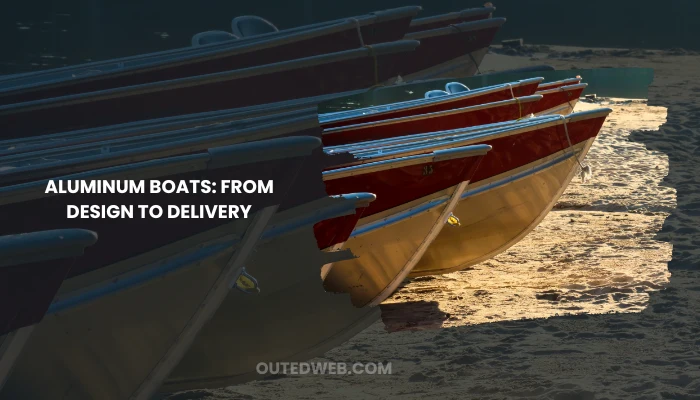
| Alloy | Magnesium Content (%) | Strength (MPa) | Corrosion Resistance | Welding |
| 5052 | 2.2-2.8 | 150-250 | Good | Fair |
| 5083 | 4.0-4.9 | 210-310 | Excellent | Good |
| 5456 | 4.5-5.5 | 310-345 | Good | Excellent |
| 6061 | 0.6-1.2 | 240-275 | Good | Fair |
While aluminum presents advantages over competing materials like fiberglass and steel, its lower ductility necessitates special consideration of factors like joint design and local stress concentrations during structural analysis.
Developments in modular design and robotic welding aim to optimize production efficiency while maintaining strength standards.
This article examines key aspects of the aluminum boat lifecycle, from material selection and structural consideration to optimized manufacturing and diverse end uses. So stay with us till the end.
Aluminum As a Boat Building Material
Aluminum has gained significant consideration in the marine field since it provides helpful characteristics. Its lightness, resilience, and protection from corrosion make it a preferable material for boat construction. Let’s explore aluminum further as a material choice for builders.
Material Properties of Aluminum
Several key properties make aluminum well-suited for boats. With a density of around 2700 kg/m3 and roughly a third of steel, aluminum delivers an exceptional toughness-to-mass proportion.
Its alloys, like the 5000 and 6000 series, including magnesium or silicon, correspondingly realize strong mechanical qualities. For illustration, alloys 5086 and 5083 achieve final tensile strengths of approximately 300–350 MPa.
Arguably aluminum’s greatest benefit is its remarkable protection from decay. Upon contact with air or water, a protective oxide layer of aluminum naturally develops, protecting the bare metal underneath.
This self-healing skin gives aluminum excellent longevity in marine environments. Unlike steel, which rusts, or wood, which rots, aluminum holds up remarkably well over time. It is non-porous and impervious to water absorption.
Moreover, aluminum has high thermal conductivity, standing up to temperature fluctuations without damage. It is also non-magnetic and does not absorb water. These latter properties make aluminum especially suitable for vessels employed across various seasons and conditions.
Aluminum Alloy Selection
As mentioned earlier, the 5000 and 6000 series are the primary marine-grade aluminum alloys. The 5000 group contains 1–6% magnesium by weight for added strength. Common 5000 alloys include 5052, 5083, and 5086.
These supplies have tensile strengths around 125–186 MPa with good malleability. Alloys in the 6000 series contain 0.1–1.5% silicon and 0.4–1.2% copper.
This improves castability compared to 5000 alloys, though strength is reduced. Common 6000 alloys are 6061 and 6063, with ultimate tensile strengths around 25,000–30,000 psi.
Considerations in alloy choice include the balance of strength versus cost and weld ability. With reduced requirements, 5052 can suffice where higher strengths aren’t essential.
However, for substantial structures, 5083 or 5086 are preferable due to their increased strength and fatigue properties. Brazed alloy 5083 is commonly chosen for seawater applications demanding higher strength.
While less corrosion-resistant than 5000 alloys, 6000 alloys may offer fabrication advantages where strength is less critical, such as for deck hardware. Overall, composition varies by manufacturer, so tests are recommended for key properties.
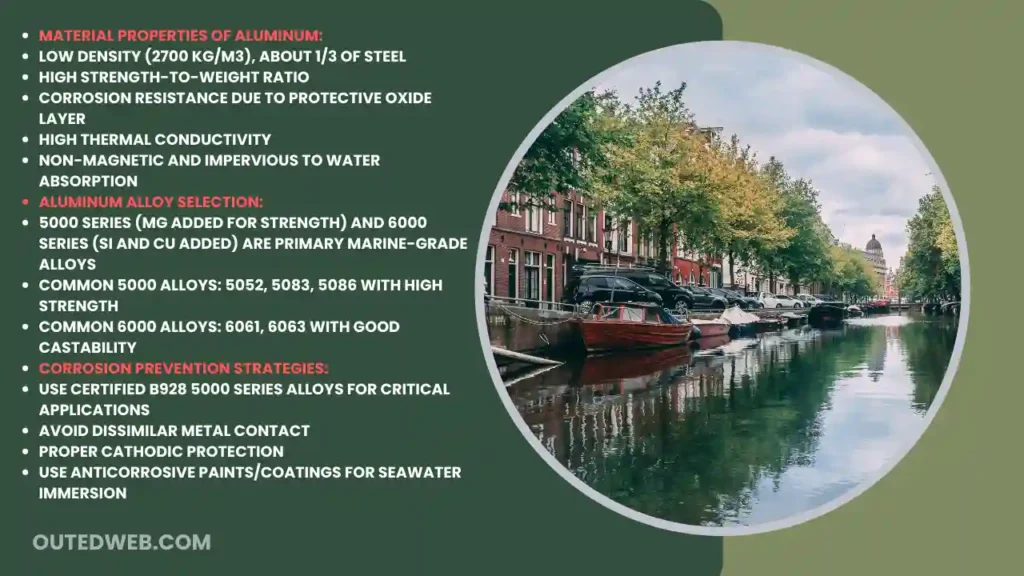
Corrosion Prevention Strategies
Marine-grade aluminum alloys resist corrosion through the formation of a tightly adherent oxide skin. However, this layer can degrade under certain conditions. Proper material selection and protection strategies are thus required.
The 5000 series supplies the highest corrosion resistance. For critical applications, only certified B928 alloys should be used. Alloy 5052 may suffice where strength is less important, offering a good economy while avoiding sensitization issues.
Protective potentials should stay in the range of -0.70V to -1.3V versus a saturated calomel electrode for seawater. Dissimilar metal contact must be avoided through careful design, coatings, and insulation wherever steel, copper, or galvanized materials come into contact.
Proper cathodic protection is also vital, sized to protect the entire underwater structure, especially in low-conductivity waters. External coating systems defend hulls further. For seawater immersion, anticorrosive paint provides a practical balance between cost and protection.
With prudent material choices, design practices, and protective measures, aluminum can deliver decades of reliable service fighting the forces of corrosion in marine applications. Its natural resilience simply requires some prudent supplementation for optimal long-term performance.
Aluminum Boat Design
Aluminum’s favorable properties make it well-suited for boat construction. Let’s delve deeper into key aspects of aluminum boat design.
Hull Design Considerations
Boat hulls experience various impact loads that must be properly managed. Waves generate some of the harshest loads, with slamming producing localized impacts. Analyzing slamming allows quantifying pressures to size structure accordingly.
Savitsky and Brown developed methods for predicting bottom- and bow-planing resistance that are widely employed. Their approach enables optimizing boat shape by assessing the impact of parameters like length and speed on resistance. Models like finite element analysis further refine structural response modeling.
Extreme accelerations also induce structural loads. Rules often estimate accelerations based on empirical experience. Advanced analyses using Zarnick wedge theory or finite element modeling verify loads more precisely.
Hull forms aiming to shed green water taken on deck require special slamming consideration. Standards like ISO 12217 and 46 CFR evaluate stability in following or beam seas to address this.
Modular Construction Techniques
Adopting modular construction facilitates robotics by boosting part commonality across products. This extends the welding series, distributing investment.
MFD provides a framework for systematic modularization. Identifying key “module drivers” during QFD aids in grouping functions into modules. The module indication matrix explores integration opportunities.
Modular fixtures allow consistent yet adaptable setups for varied boat models. Self-locating joints simplify installation while reducing errors from misalignment.
Reducing part counts cuts associated costs substantially. Modularization streamlines the assembly and testing of separate modules before joining.
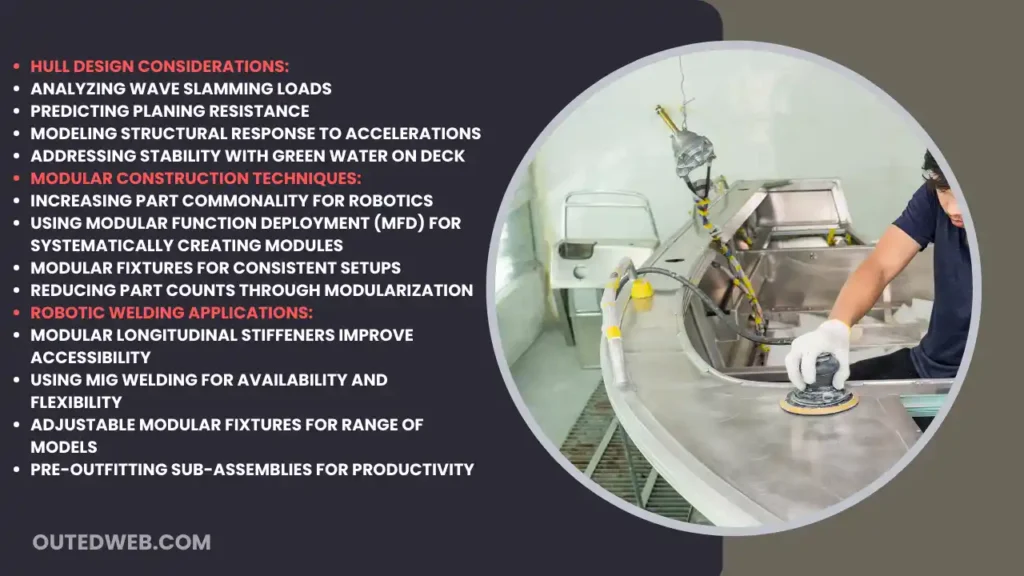
Robotic Welding Applications
Poor accessibility hinders robotics for conventional stiffener construction. The modular longitudinal stiffener structure resolves this, freeing more space for tooling.
MIG remains preferable due to equipment availability and process flexibility. Pulsed MIG further reduces heat input without sacrificing deposition rate.
Modular fixtures incorporate adjustable settings to suit a range of models. This shared fixture amortizes investment across multiple vessels.
Interchangeable sub-assemblies are pre-outfitted off-line for maximum productivity. Internal welding accessibility improves for remaining joins.
Aluminum Boat Manufacturing
Let’s dive deeper into key aspects of aluminum boat construction. Manufacturers adopt various forming and joining techniques, so understanding these processes proves worthwhile.
Forming Methods
Crafting durable hulls involves thoughtful material forming. Two prominent methods include roll forming and press-braking.
Roll-forming streamlines boat component creation. By passing sheet aluminum through sets of specially shaped rollers, machines imprint precise corrugations, imparting strength. These indentations substitute for additional stiffeners and lightening construction.
Roll forming necessitates specialized roll tooling but forms precise corrugations rapidly. With computer-controlled rollers, manufacturers tailor patterns matching precise hull geometries. During forming, the material stretches minimally, reducing the distortion risk.
Press brakes also shape aluminum economically. Using shaped dies, these mechanical presses form contoured plates through controlled plastic deformation. Brake tooling costs less than roll tooling while attaining variable double curvature.
For small workshops, multipurpose hydraulic brakes suffice. Larger builders utilize dedicated high-tonnage versions. Regardless, draping aluminum to a single thickness eases stress concentrations versus thicker stock.
Joining Technologies
Connective methods unite panels. Often, robotics streamlines joining for optimum part flow.
MIG welding dominates boatbuilding thanks to accessibility. However, aluminum welding demands specialized procedures. Pulsed MIG current profiles minimize heat input without sacrificing deposition rate.
High-deposition pulses transfer molten droplet trains each period. Background currents minimize heat between pulses. Together, these characteristics reduce distortions and burn-through risk.
Friction stir welding (FSW) shows promise, producing high-integrity seams without fillers. Rotating tools plunge gradually, stirring rather than melting parent metal. Resultant HAZs are minute. FSW shows good fatigue strength for aluminum alloys. Research optimizes parameters for boat builders.
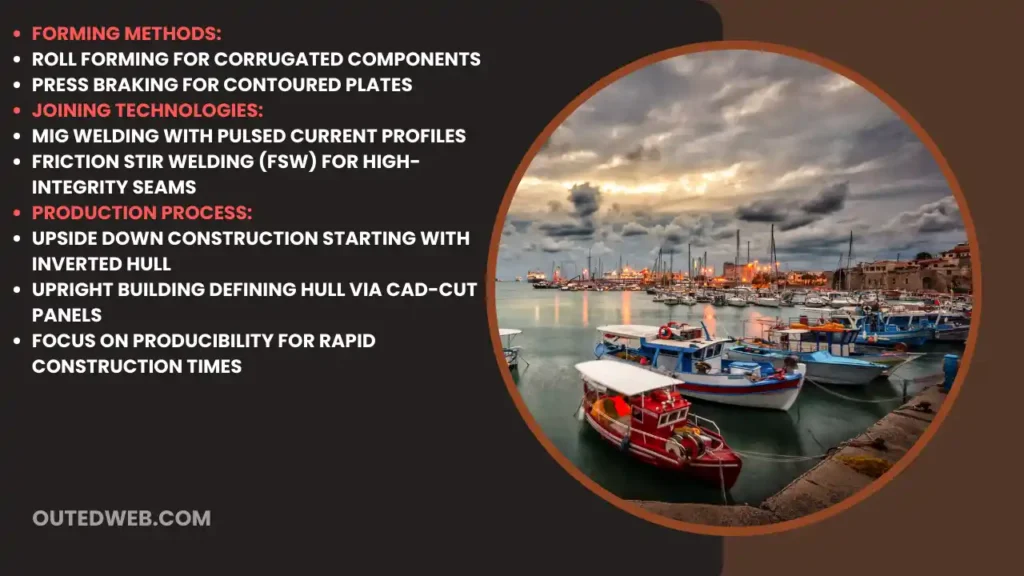
Production Process
Coordinating forming and assembly enhances productivity. Diverse approaches exist.
Upside down construction locates structure establishment in an inverted hull. Internal frames, bulkheads, and longitudinals are erect on the backbone or deck, simplifying jig requirements.
External joining occurs once the boat is righted. While internal welding remains overhead, workers face fewer access issues. However, this ties the hull definition to the built structure.
Upright buildings define the hull independently via CAD-cut panels. Internal outfitting proceeds in stages, with machinery mounted and bulkheads installed as work progresses upward and outward.
Deckhouse and deck installation conclude the process, with outfitted subassemblies combining as the hull rises. Overhead access improves, while structure defines the hull more flexibly.
With care taken to consider factors such as producibility, aluminum boats showcase low maintenance operation coupled with rapid construction times. Designs impacting these factory efficiencies prove pivotal to success.
Aluminum Boat Applications
Aluminum is well-suited for an assortment of maritime uses owing to its power, corrosion resistance, and flexibility. Now, we will investigate the precise employment of aluminum boats for work ships, high-velocity watercraft, and recreational purposes.
Work Boats
Workboats have rigorous duty cycles transporting crews and cargo, so structural integrity is crucial. Aluminum excels as a workboat material due to its durability in tough operating conditions.
Crew boats routinely ferry personnel for offshore oil rigs, averaging hundreds of hours annually in open ocean transits. Their aluminum hulls withstand the punishing impacts of wave slamming year after year.
Aluminum is also prevalent in utility vessels performing tasks like aids to navigation maintenance, where durability enables boats to serve remote buoys over numerous seasons.
High Speed Crafts
High-speed craft requires light, stiff materials to plane effectively. Aluminum satisfies this need, making it extensively used in fast passenger ferries racing between ports. Some ferries approach 50 knots, stressing hull structures.
Aluminum retains strength at high speeds better than alternatives like fiberglass, favoring its use. Military craft also depend on aluminum for its properties, enabling high-speed maneuvers in extreme conditions. Riverine patrol boats perform force protection at over 30 knots, relying on aluminum construction.
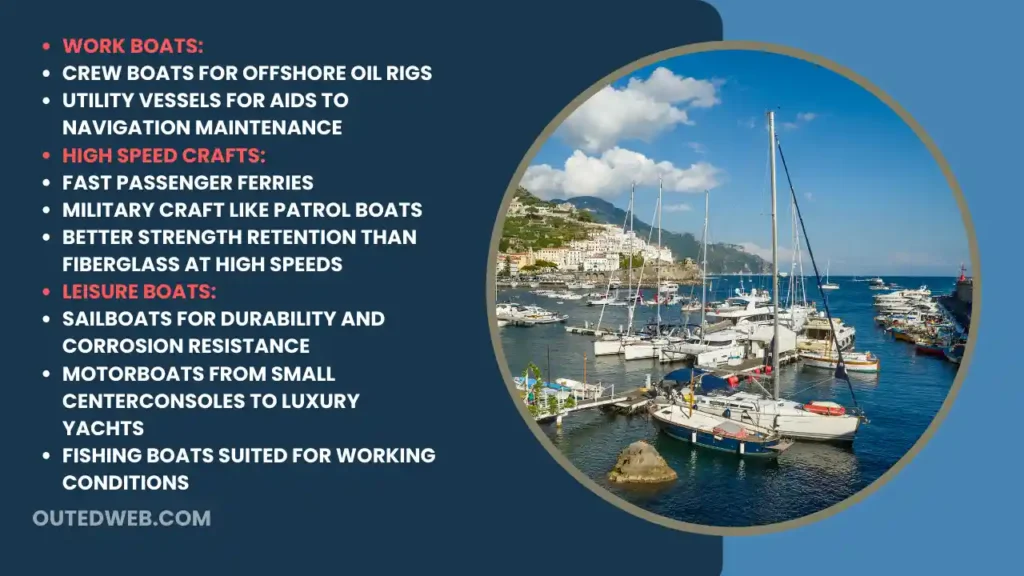
Leisure Boats
Leisure boats represent the largest market, where aluminum finds roles in sailboats, motorboats, and more. Sailboats value aluminum for its durability, and corrosion resistance, allowing decades of service.
Motorboats employ aluminum hulls, from small center consoles to luxury yachts. Aluminum confers weight savings over fiberglass, which is important for performance. Its light weight also eases trailering and hoisting boats from the water.
Numerous fishing boats are constructed of aluminum due to their properties that suit working conditions at sea.
Industry Outlook
As mentioned earlier, Aluminum remains a popular material choice for various marine vessel applications due to its properties of strength, corrosion resistance, and versatility. Now, we will examine current industry trends, regional focuses, and future technologies related to aluminum in the marine sector.
Production Trends
Over the past few decades, the aluminum boat industry has seen steady growth in production trends. However, the level of automation in manufacturing processes has remained relatively low compared to other marine industries.
Typically, aluminum boats are constructed using traditional approaches involving intensive manual work. While lightweight aluminum offers many advantages over alternatives for its durability and corrosion resistance, the construction of individualized designs poses challenges to robotic utilization.
However, rising demand from commercial and military applications has driven an increased focus on efficient production methods. Modular design approaches now facilitate improved utilization of robotics by standardizing construction.
By subdividing complex hull structures into simpler modular sub-assemblies, variation across boat models can still be accommodated while capturing mass production efficiencies. This has enabled enhanced competitiveness through reduced costs and lead times.
Notably, specialized extrusions and pre-formed sheet components are being incorporated to a greater degree, replacing hand assembly of smaller fabricated parts. Similarly, standardized outfit packages are enabling more automated installation. Overall, production techniques continue to trend toward higher levels of mechanization and automation through innovative solutions.
Regional Focus
In terms of geographic production centers, the majority of aluminum boat-building activity remains focused in North America and Western Europe due to technical expertise and established supply chains. However, some niche regional strongholds have also emerged.
Scandinavia boasts a vibrant aluminum craft industry catering to offshore demands. Northern European builders tailor seaworthy designs for the severe maritime environment. Australia has cultivated niche expertise through builds for frontier applications like coastal patrols. Production likewise thrives for domestic fishing and leisure markets.
Growth also continues apace in Asia. Chinese and Japanese yards increasingly compete globally thanks to advanced manufacturing capabilities. The commercial fishing industry particularly drives Asian aluminum boat construction. Investments in automation aim to bolster cost competitiveness versus import reliance.
Overall, aluminum boat production clusters follow concentrations of technical know-how paired with local maritime industry demand. Proximity to experienced aluminum boat engineers and fabricators reinforces regional specialization. Established supply networks further entrench production centers.
Future Technologies
Looking ahead, several emerging technologies hold promise to further enhance aluminum boat design, construction, and performance. Advanced manufacturing techniques like 3D printing and friction stir welding open new possibilities.
Lightweighting also remains a driving focus through innovations in aluminum alloys and composite incorporation. Intelligent systems integration portends new capabilities.
Additive manufacturing enables complex internal geometries previously unachievable. 3D-printed aluminum parts achieve high strength with less weight. Localized deposits eliminate wasted material. Complex stiffening becomes feasible without compromising hull access. Unique design optimizations emerge from design freedoms.
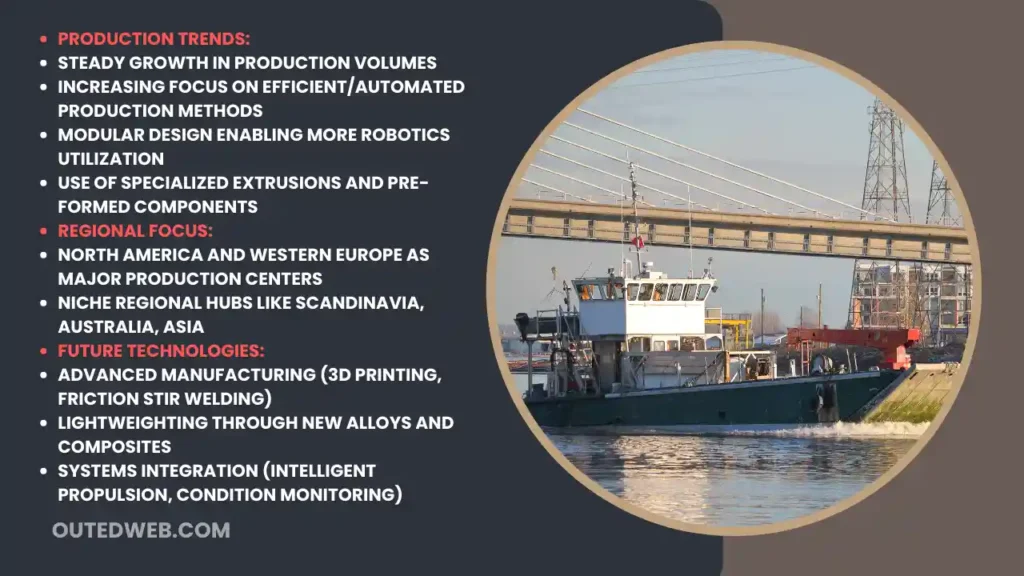
Friction stir welding expands the ability to join aluminum. Specialized tooling overcomes oxide films for sound, low distortion, and superior-strength welds. Difficult joints become straightforward. Integrated hardware installation simplifies monolithic construction.
Composite applications expand as bonding and processing advance. Carbon fiber reinforces localized load areas. Sandwich panels reduce weight while maintaining stiffness. Hybrid structures optimize characteristics at minimal cost premiums.
Integration of automation and data fusion systems enhances functionality. Intelligent propulsion maximizes efficiency. Condition monitoring ensures optimal availability. Unmanned boats perform repetitive duties affordably and securely. Advanced controls enhance maneuverability and mission effectiveness.
Frequently Asked Questions
How Can the Structural Integrity of Aluminum Boats Be Analyzed And Ensured?
Several structural design codes and classification rules apply analysis methods for aluminum boats, such as ISO 12215, DnV, and ABS rules. Loads are determined based on accelerations from wave impacts, with pressure factors adjusted for location, speed, and geometry.
The resulting forces are applied to simplified structural models, considering effective widths, curvature effects, and plastic section modulus. Allowable stresses implicitly include safety factors.
Computer analyses like FEA can supplement rule checks. Limits on weights, centers of gravity, and floodable lengths are established based on intact and damaged stability criteria.
Standards on construction details, load transfer, and sub-compartmenting further ensure integrity. Overall, rules provide a framework, while more rigorous analyses optimize designs within safe operational envelopes.
How Does Modularization Help in the Manufacture of Aluminum Boats?
Modularization increases standardization in boat construction, allowing production efficiencies while retaining customization options. By subdividing complex hull structures into simpler, standardized modules, robotic welding becomes applicable even in low-volume production.
Modules can be mass produced, and variations can be accommodated through module combinations. Standard modules extend welding series across multiple boat models, distributing capital costs.
Prefabricated outfits facilitate module integration. Assemblies occur simultaneously, shortening cycle times. Modular fixtures position standardized parts automatically for robotic welding. Complex interfaces are cleared in advance.
What Welding and Joining Methods Are Commonly Used in Aluminum Boat Buildings?
Gas metal arc welding (GMAW), also known as MIG welding, is the predominant welding process for aluminum boats due to its capabilities in various positions and high deposition rates. Pulsed MIG techniques reduce heat input without compromising weld quality.
Gas tungsten arc welding (GTAW) is employed where high-quality aesthetics are required, such as on superstructures. Friction stir welding expands join ability without shielding gas or filler metals.
Adhesive bonding is utilized where access inhibits welding. Mechanical fasteners combine with adhesive for joints experiencing vibration. Specialized techniques address double curvature and limited weld access areas inherent to boat construction. The processes are carefully matched to the material and joint type.
Final Verdict
Aluminum has proven itself as a versatile and advantageous material choice for a wide range of boat applications. Its properties of strength, corrosion resistance, and versatility have supported its use in boats for decades.
Production methods continue to advance to optimize aluminum boat design, construction efficiency, and overall performance through innovations like modularization. Regional boatbuilding clusters remain important for propagating technical expertise.
Emerging technologies also hold promise to further enhance aluminum boats. Overall demand has grown as aluminum’s inherent qualities make it well-suited to serve marine transportation needs. Continued material innovations and refined manufacturing techniques portend aluminum’s ongoing role in supporting diverse marine transportation into the future.

